1. INTRODUCTION
Concrete is a widely used material applied worldwide in construction due to advantages such as good resistance to compression, low cost and ease of production. This last feature in conjunction with performance is directly linked to the useful life of the building, which can be defined as the period in which the structure is able to guarantee not only its stability but all the functions for which it was designed (Bertolini, 2010). The degradation of concrete structures and the consequent reduction of their performance is a frequent problem worldwide. Durability problems in these structures can be caused by a number of factors including lack of knowledge of the environment that will be exposed, inadequate specifications and / or poor execution.
The environment in which the structures will be exposed exerts a direct influence on the behavior of the material used. In this sense, the 1990s showed that concrete as a building material is unstable over time, and its physical and chemical properties are altered in function of the characteristics of its components and their responses to the environmental conditions (Souza and Ripper, 2009).
The form of deterioration that has shown to be of greater incidence and with greater economic losses in several countries is the corrosion of reinforcements (Carmona, 2005). This mechanism of deterioration is a consequence of the interaction of the material with the medium, allied or not to mechanical stresses (Gentil, 2003). One of the main aggressive agents that can generate this process of deterioration are the chloride ions (Helene, 1997). The corrosion caused by the penetration of these ions inside the concrete is of electrochemical nature, involving an anodic reaction where the oxidation of the metal occurs, and another one of cathodic nature, occurring simultaneously. In order for corrosion of steel reinforcement to occur, it is necessary to have four elements: the conductor, which is the steel bar itself, the electrolyte (water) to conduct the ions, the oxygen that forms the corrosion products and a difference of potential for formation of two distinct areas (the ones of anodic and cathodic nature). This latter factor can be caused by different intensities of concrete densification, differences in aeration, humidity or salt concentrations (Silva, 2006).
The frequency of corrosion and the problems associated with it show the need to find solutions that contribute to minimize this deterioration process and its evolution in reinforced concrete structures (Vieira, 2003). Life expectancy models play an important role both in assisting existing structures, evaluating their deterioration and in new constructions, collaborating in the design stage, so that according to the environment in which they will be exposed, they have the expected life. It is also of fundamental importance that the application of the models of prediction of useful life is associated with the natural degradation of the structure, where the real interaction of this with the environment in which it is exposed occurs.
From the above mentioned, this study had as objective to verify the compatibility of a model of prediction of useful life, existing in the literature, with the penetration of chlorides in concrete elements, exposed in an urban environment in the city of Pelotas / RS.
2. PROCEDURE
The methodology of this work was divided into two stages. The first one refers to the natural test, through the exhibition of concrete bodies-of-proof in different places of the city of Pelotas / RS. The second stage is based on the application of a predictive model of useful life and later comparison of the results with the values found in the natural exposure of the samples.
2.1 Natural test
2.1.1 Exposure of bodies-of-proof
For this work, 60 cylindrical bodies-of-proof (10 x 20 cm) of concrete were used, provided by a local construction company as a way of simulating real concrete used in the city and its interaction with the environment. The samples were made with water / cement ratio of 0.6, CP IV - 32 cement from Votoran (most common cement in the region) and resistance to compression (fck) of 20MPa (minimum value considered for structural concrete according to NBR 6118 ).
The city of Pelotas / RS is located approximately 60km from the sea region and is located on the banks of the São Gonçalo channel that connects the Patos and Mirim Lagoons. Thus, the samples were exposed in an urban environment with annual relative humidity above 70% and unprotected from the environment (rainwater, temperature and rainfall), and could be classified as C3 according to NTF 4015 (Technical Standard Fondonorma, 2012). Strategic points of the city were determined, due to the greater circulation of vehicles and greater concentration of dwellings. The choice of sites, which represent each region, was influenced by the ease of access, as well as availability of physical space due to the large number of bodies-of-proof that would be placed at each site. Thus, the bodies-of-proof were divided into five different locations in the city: downtown, Porto neighborhood, Fragata neighborhood and Três Vendas neighborhood (due to this last neighborhood extension, two sites were chosen for the exhibition of the bodies-of-proof). Thus, 12 bodies-of-proof were placed in each locality. Figure 1 shows the location of the different points analyzed.
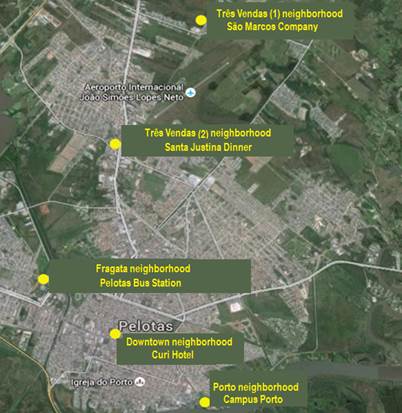
Figure 1 Mapping of the location of the bodies-of-proof in the city of Pelotas / RS. (Adapted from Google Earth).
The Três Vendas neighborhood is located in the northern part of the city. The first site, shown in Figures 2 and 3, is further away from the central area, but where all the traffic from the city's potteries flows. The second location of this neighborhood (Figures 4 and 5) is located in the most central part where the meeting of two of the main avenues occurs, with intense traffic around them.
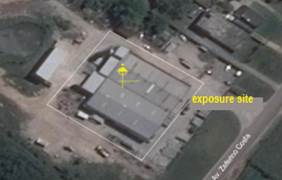
Figure 2 Location of the first environment of exposure of the samples in the Três Vendas neighboorhood (Adapted from Google Earth).
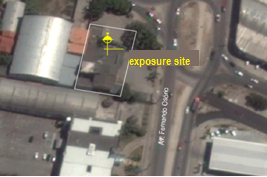
Figure 4 Location of the second environment of exposure of samples in neighborhood Três Vendas (Adapted from Google Earth).
The Fragata neighborhood, located in the western zone, is one of the most populous neighborhoods in the city. Despite its extension, only one place was chosen for its analysis, due to its easy access, which is the city's Bus Terminal, shown in Figures 6 and 7.
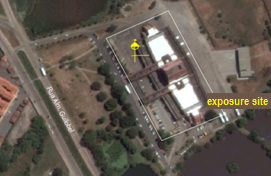
Figure 6 Location of the environment of exposure of samples in neighborhood (Adapted from Google Earth).
The downtown district test site is located in the main street of the neighborhood, being highly populated and of intense traffic, as shown in Figures 8 and 9.
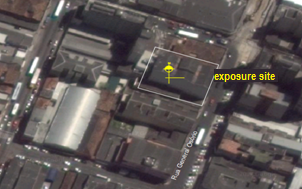
Figure 8 Location of the environment of exposure of samples in downtown neighborhood (Adapted from Google Earth).
Unlike the other sites, in the Porto district, located in the south of the city, the bodies-of-proof were exposed at the edge of the São Gonçalo channel (Figures 10 and 11).
2.1.2 Compression resistance test
The Forney brand hydraulic press was used to test the resistance to compression of the samples from each locality, the test was performed according to NBR 5739 (ABNT, 2007). This test was done with three bodies-of-proof from each locality every 4 months, being performed to verify the resistance, which should be at least 20 MPa, and opening the sample to perform the colorimetric test. The average evolution of the resistance to compression throughout the test is presented in Table 1, where it is noticed that all the samples reached the minimum resistance and were then submitted to the colorimetric test. Measurements of dispersion were not performed for this test, due to the fact that this characteristic is not the focus of the analysis.
Table 1 Average resistance to compression of concrete bodies-of-proof
| Location | Time of exposure | |||
|---|---|---|---|---|
| 4 months | 8 months | 12 months | 16 months | |
| Fragata | 27.44 | 32.17 | 34.05 | 35.47 |
| Downtown | 24.48 | 30.52 | 31.61 | 30.28 |
| Porto | 26.99 | 33.22 | 32.34 | 32.87 |
| Três Vendas 1 | 26.99 | 34.33 | 33.39 | 35.37 |
| Três Vendas 2 | 28.65 | 33.99 | 30.85 | 35.70 |
With the value of the resistance to compression of each site the average per period was made, and based on the NBR 6118 (ABNT, 2014) the curve of evolution of this characteristic was traced over time for the type of cement used in the bodies-of-proof (CP IV).
2.1.3 Depth measurement of chlorides
After the rupture of the bodies-of-proof, silver nitrate was applied to the whole newly fractured face. When this solution is sprayed on the concrete surface a photochemical reaction occurs, where in the presence of free chlorides, a white precipitate of silver chloride occurs and in the region without chlorides or with combined chlorides, a brown precipitate is formed, the silver oxide (Real et al., 2015). The appearance of the samples after the procedure, the chloride penetration front and the depth measurement are shown in Figures 12 and 13.
After the silver nitrate was sprayed, we waited about 5 minutes until the solution reacted with the concrete. Then the measurement was performed, being made two in each body-of-proof, resulting in 6 values of chlorides depth per site of exposure. In order to predict depth of aggressive agents, we assumed that the greater depth has greater relevance, this, therefore, was the measure used to analyze the results.
2.1.4 Statistical analysis
For the evaluation of the influence of the study variables on the chloride depth data obtained in the tests, the two-way ANOVA test was performed. For that, the SPSS 20.0 (Statistical Package for Social Sciences for Windows) software was used. For all the analyzes a level of significance (α) of 5% was used, that is, from this value the deviations are considered not significant, presenting a confidence level of 95%. Thus, one can reject the hypothesis that the averages are all equal to 5% if the value of "p" found is less than this value. For statistical analysis, the sample location (Fragata neighborhood, Downtown, Porto, Três Vendas 1 and Três Vendas 2) and the time at which they were exposed (4, 8, 12 and 16 months) were considered as independent variables. The penetration depth of chlorides was considered as a dependent variable.
2.1.5 Climatic characterization of the city of Pelotas / RS
Data were collected to characterize the local atmosphere in order to verify the aggressiveness of the samples' exposure environment. The relative humidity of the air, temperature and precipitation quantitative were highlighted as factors of greater influence. It is important to highlight that the monitoring was performed in the macro-climate of the sample exposure environment, in this case the city of Pelotas / RS. These data were obtained through the Pelotas Agroclimatological Station website, located in Capão do Leão, which provides daily and monthly meteorological variables. Figures 14, 15 and 16 show the accumulated precipitation, the mean relative humidity and the maximum and minimum temperature in the months for the 4 periods studied (4 months, from May to September, from 4 to 8 months, being September to January, from 8 to 12 months, referring from January to May, and from 12 to 16 months, from May to September). For the application of the useful life model, we used data of the relative humidity and maximum and minimum daily temperature, for which the average was calculated. No information was collected regarding the orientation of the winds during the studied period, due to the difficulty of analyzing this variable in relation to the different exposure sites.
2.2 Useful life expectancy model
For the analysis of chlorides in concrete structures, the model of Bob (1996) was chosen, since the estimation made by this method is carried out in terms of the depth covered by the contaminant, rather than the analysis in terms of concentration, as a large part of the models for chloride analysis. Bob (1996) initially presented a model used for analyzing the carbonation depth in the structures, and after verifications based on experimental long term data, noted that equation (1) could be used for modeling the chloride process of penetration (Andrade , 2001). This model considers concrete properties, such as compressive strength, and environmental characteristics, such as temperature and relative humidity.
Onde:
At where:
xm |
= average depth of penetration of chlorides (mm); |
fc |
= compressive strength of concrete (N / mm²); |
c |
= ability to fix chlorides according to the type of cement; |
k1 |
= coefficient of influence of temperature; |
k2 |
= coefficient of influence of relative humidity; |
t |
= time (years); |
d |
= ratio between the critical concentration and the surface concentration of chlorides in the structure. |
For the application of this model, we used the average temperature and daily relative humidity of the city of Pelotas / RS during the period of exposure of the samples, as well as the average daily resistance to compression (fck) of the concrete obtained through the evolution curve of this characteristic. The parameters c, k1 and k2 are presented in Table 2. The model was applied to different values of parameter d as a way of analyzing different critical and superficial concentrations of chlorides in the structure, since this variable represents the relation between the two concentrations.
Table 2 Parameters related to Bob’s model, 1996 (Andrade, 2011)
| Parameter k1 | Parameter c | Parameter k2 | Parameter d | ||||
|---|---|---|---|---|---|---|---|
| k1 | T(°C) | c | (%) additions in cement | k2 | UR (%) | D | r |
| 0.67 | 0 to 5 | 1 | 0 | 0.75 | 50 | 2 | 0 to 19 |
| 0.75 | 5 to 15 | 0.9 | 15 | 1 | 85 | 1 | 20 |
| 1 | 15 to 25 | 0.75 | 30 | 0.75 | 100 | 0.5 | 50 |
| 1.25 | 25 to 35 | 0.67 | 50 | - | - | 0.33 | 65 |
| 1.5 | 35 to 45 | - | - | - | - | 0.16 | 85 |
3. RESULTS
3.1 Depth of chlorides by the natural test method
The maximum penetration depths of chlorides for the different exposure sites and the different times are shown in Figure 17.
Evaluating the data, one observes, as expected, a tendency of increase of the chlorides front between the first and last measurement for all the localities. It is observed that the greatest depth of penetration of chlorides after the 16 months of exposure in urban environment, were found in the neighborhood Fragata and Porto, being 10mm. This value was surprising, since it was not believed that free chlorides would be found inside the city of Pelotas, since it is a city far from the maritime environment.At the same time, it is known that the Patos lagoon, which surrounds the city, has periods in the year that changes the state from fresh water to salt, and can be an explanation for appearance of chlorides in concrete, being also important to emphasize that, in periods of low rainfall, high chloride values were found at some points from the Mirim lagoon to the Patos Lagoon (Souza, 2015) and chloride values above the value established by CONAMA for fresh water at points on the Bento Gonçalves Avenue extension channel (Santos et al. al., 2012). It can be said that there is an indication that the chlorides are part of the atmosphere of the city of Pelotas / RS, where the lowest depth found for this same exposure time was 8mm for the Downtown neighborhood and for samples 1 of Três Vendas neighborhood.
Through the two-way ANOVA, it was possible to confirm the influence of the time variable on the depth of chlorides, and it was verified that the local variable and the interaction between these variables did not influence. From this analysis it is verified that the entire city of Pelotas / RS has the same behavior regarding the penetration of chlorides, not interfering the change between neighborhoods, only the time of exposure. Analyzing in isolation as a way to verify which variables differ in relation to the depth of chlorides, it was found that time significantly interferes in the results of exposure to chloride penetration. On the other hand, the analysis of the "local" independent variable indicated a significant difference in the first location of the Três Vendas neighborhood in relation to the Porto and Três Vendas 2 sites, indicated by p ≤ 0.05. For the other sites, no significant difference was found, accepting, then, the hypothesis of equal means between these and the depths of chlorides, being important to emphasize that the results have a confidence level of 95%.
3.2 Application of Bob's model (1996)
The application of the predicted lifetime model for chlorine penetration was performed only for sites that presented significant difference in the statistical analysis of the data, being for the first and second site of the neighborhood Três Vendas and Porto neighborhood. Figures 18, 19 and 20 present the comparison between the results found with the application of the model and the natural test, for the different values of d.
It is observed that for all the localities the model that best fit the values found in the natural test was the one with parameter d = 2, that is, with the relation between critical concentration and the superficial concentration of chlorides in the structure between 0 and 19. It was also observed that for the second period none of the sites had their values described by the applied model, unlike the other periods of exposure.
By analyzing each site separately for the best curve found, and based on the input parameters of the model, it can be said that for the neighborhood Três Vendas 1, for the first period (depth of 5mm), we found the approximate value of 4.92mm at 71 days of exposure, with a mean temperature of 16.4ºC and a relative humidity of 85%. For the second period (depth of 5 mm) the approximate value of 4.92 mm depth was also found for 188 days of exposure, mean temperature of 24.9 ° C and relative humidity of 88%. In the 3rd period (depth 6.7 mm), we found 6.69 mm at 340 days of exposure, with a mean temperature of 16.1ºC and relative humidity of 85.8% and 6.71mm at 342 days, mean temperature of 12ºC and relative humidity of 83.8%. For the 4th period (depth of 8mm), we found 7.65mm for 486 days of exposure, average temperature of 17.1ºC and relative humidity of 76%.
For the Três Vendas 2 neighborhood, in the first period where the depth found in the natural test was 3mm, when applying the model, this exact value was found at 47 days of exposure, average temperature of 16.95ºC and relative humidity of 95.20 %. In the 2nd period where the depth of the natural test was the same, the closest value found by the model was 3.93mm with 120 days of exposure, average temperature of 15.7ºC and relative humidity of 86.50%. For the 3rd period, the same value of the natural test (depth of 6mm) was found for 273 days of exposure, average temperature of 25ºC and relative humidity of 86.3%. For the last period (depth of 8.5 mm), the model obtained a depth of 8.81 mm at 363 days of exposure with a mean temperature of 16ºC and a relative humidity of 82.30%.
Finally, for Porto neighborhood in the 1st period, the value of 4mm was found in the natural test, while in the model it was obtained 3,99mm at the 83 days of exposure with average temperature of 17.9ºC and relative humidity of 90,80%. In the second period, this neighborhood had the same behavior of the neighborhood Três Vendas 1, while in the 3rd period the value found was the same for the neighborhood Três Vendas 2. For the 4th period (depth of 10mm), the model found the approximate value of 10.02 mm for 469 days of exposure, average temperature of 16.9ºC and relative humidity of 83.50%.
In general, for the city of Pelotas / RS, the model of Bob (1996) was applied for each period of exposure of the bodies-of-proof. We used 85% as relative humidity, due to the humidity of all periods being close to that value. As for the temperature, as a great daily variation occurs, the maximum and minimum temperatures of each period were used. As for the resistance to compression, the average of all the sites in each period was used. The result is shown in Table 3 and Figure 21.
Table 3 Comparison of the results of the natural test with Bob's model, 1996
| Exposure time (months) |
Depth of chlorides (mm) | ||||
|---|---|---|---|---|---|
| Três Vendas 1 | Três Vendas 2 | Porto | Bob (1996) | ||
| Bob Tmax | Bob Tmin | ||||
| 4 | 5 | 3 | 4 | 4.8 | 5.76 |
| 8 | 5 | 3 | 3 | 5.01 | 5.61 |
| 12 | 6.7 | 6 | 6.7 | 6.19 | 6.93 |
| 16 | 8 | 8.5 | 10 | 7.65 | 9.17 |
By analyzing the results, the period that was closest to the model of Bob (1996), for both temperatures was 12 months, being close to the values found for the neighborhood Porto and Três Vendas 1 using the minimum temperature, and the neighborhood Três Vendas 2 using the maximum temperature. For the 4-month period, the values found only approached the depth found in the neighborhood Três Vendas 1, the closest one being the result found using the maximum temperature. While for 8 months the model also resulted in a value very close to the one from neighborhood Três Vendas 1 for the maximum temperature. After the 16-month period, regardless of temperature, the results obtained were smaller than for the natural test, where the value found with the highest temperature approached the Três Vendas 1 neighborhood and the highest depth (9.17 mm) was found with the lowest temperature. This difference may be due to the large daily temperature variation of the city of Pelotas / RS, as well as the fact that the model considers only certain values of relative humidity (50%, 85% and 100%), and humidity for all periods is between 85 and 100%.
4. CONCLUSIONS
Firstly, when observing the results found in the natural test for chloride penetration, there is a tendency to increase between the first measurement made after 4 months of exposure and the last one after 16 months for all analyzed sites.
The values obtained for the penetration of chlorides demonstrate that the city of Pelotas / RS, despite being removed from the marine environment, favors the advance of this aggressive agent to the interior of the concrete due to high humidity and temperature variations that lead to wetting / drying cycles of the concrete, facilitating the absorption and advancement of chlorides inside the structure. Analyzing the largest (10mm for the Fragata and Porto neighborhoods) and lowest (8mm for Três Vendas 1) depth value of chlorides for a 16-month exposure time, a variation of approximately 20% was found.
With the use of statistical analysis it was confirmed that the time variable significantly interfered in the results of exposure to chloride penetration, and it was observed that the change between neighborhoods and the interaction between the sites and the time did not have any influence. Through the multiple comparison test we found a significant difference between the Três Vendas 1 site and the Porto and Três Vendas 2 sites..
When applying the model of predicted useful life of Bob (1996) to analyze the penetration of chlorides, it was possible to perceive that for all the places the option that best fit the values found in the natural test was using the parameter d = 2 , that is, with the ratio between the critical concentration and the surface chlorides concentration in the structure ranging from 0 to 19. Analyzing the sites separately, and each exposure period, it is noticed that depending on the values of the input variables (time, temperature and relative humidity) were found to be close to depth over time for all localities. However, when applying the prediction model in general for the city of Pelotas, we can see that the values obtained approximated the data collected in the natural trial for the 12 months of exposure in neighborhoods Três Vendas 1 and Porto, using the minimum temperature, and the neighborhood Três Vendas 2 to the maximum temperature. For the 4 and 8 months times, the model presented values very close to the neighborhood Três Vendas 1.
It is concluded that the model of Bob (1996) showed differences between the values obtained with its application and the data of the natural test, probably due to the great daily temperature variation of the city of Pelotas and the fact that the model considers only certain values of humidity (50%, 85% and 100%) and the humidity in the city in question, for all periods, is between 85% and 100%. However, the model applied even with the difference found, showed good adherence to the observed data, showing adequate for some situations, demonstrating the potential to describe the behavior of chlorides depth over time for the city of Pelotas, being necessary some adjustments in the entry parameters.
Thus, with the indicative of the presence of chlorides in the analyzed city and the potential demonstrated by the method studied, it is important for future work, the verification of the chloride content in the exposure environment and the verification of the depth of chlorides in the concrete through other forms that complement the colorimetric test, so that it is possible to refine the variables applied in the model and its better application.











 nueva página del texto (beta)
nueva página del texto (beta)



















